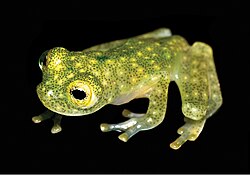Hyalinobatrachium yaku
| Hyalinobatrachium yaku | ||||||||||||
|---|---|---|---|---|---|---|---|---|---|---|---|---|

Hyalinobatrachium yaku , holotype, male, underside |
||||||||||||
| Systematics | ||||||||||||
|
||||||||||||
| Scientific name | ||||||||||||
| Hyalinobatrachium yaku | ||||||||||||
| Guayasamin , Cisneros-Heredia , Maynard , Lynch , Culebras & Hamilton , 2017 |
Hyalinobatrachium yaku is aspecies of frog from the family of glass frogs (Centrolenidae)occurringin Ecuador .
Naming
As a specific epithet , the first descriptor chose the name yaku , a word from the Kichwa language of the indigenous people , which means 'water' and refers to the elixir of life of the frogs.
features
description
The description of Hyalinobatrachium yaku is based on a male holotype. The head-torso length (SVL) is 20.8 millimeters, with the width of the head taking up 37% of the SVL. Other specimens reached head-trunk lengths of up to 22.3 millimeters. The basic color of the entire upper side of the body is strong green to yellow-green and thickly coated with small yellow spots and brownish dots. Some dark green spots in the area of the back of the head are typical of the species. The yellow spots are more pronounced in young frogs. The fingers and hind feet with adhesive pads are cream-colored and show yellow-green tips. The underside of the skin is extensively transparent so that the red heart, the digestive system, the liver, as well as the gall bladder and urinary bladder are clearly visible from the outside. The iris is silvery to yellow and has small dark spots.
Vocalizations
The call of Hyalinobatrachium yaku , which lasts 0.27 to 0.40 seconds and lies in a dominant frequency range of 5219.3 to 5329.6 Hertz, is usually repeated nine times per minute and differs significantly from other species of the genus Hyalinobatrachium . The call is transmitted in a constant high pitch, frequency or amplitude modulations were not perceived.
Similar species
Hyalinobatrachium yaku can be distinguished from other hyalinobatrachium species on the basis of genetic and morphological differences, deviating vocalizations and the area of occurrence. The dark green spots in the area of the back of the head are also missing in species that are otherwise similar to drawings, for example Hyalinobatrachium pellucidum .
Occurrence and habitat
Hyalinobatrachium yaku has so far only been detected in three small areas in the Amazon basin in the provinces of Pastaza , Orellana and Napo at altitudes between 300 and 360 meters above sea level in Ecuador. The discoverers of the species believe that it could also be found in similar biotopes in Peru . The animals live primarily in damp forests on river banks.
Way of life
The frogs prefer to stay at heights between three and six meters above the ground on the underside of leaves near slowly flowing, shallow and narrow bodies of water. The balls with the eggs, which are guarded by the males, are also deposited there. Further details on the species' way of life have yet to be explored.
Danger
Hyalinobatrachium yaku is threatened in its habitats due to mining activities and oil drilling by humans. The species is not yet listed by the World Conservation Organization IUCN . The discoverers classify the species with “ Data Deficient = insufficient data basis”.
Individual evidence
- ↑ a b c d e f Juan M. Guayasamin, Diego F. Cisneros-Heredia, Ross J. Maynard, Ryan L. Lynch, Jaime Culebras, Paul S. Hamilton: A marvelous new glassfrog (Centrolenidae, Hyalinobatrachium) from Amazonian Ecuador In : ZooKeys No. 673, May 12, 2017, pp. 1–20, doi : 10.3897 / zookeys.673.12108
Web links
- tierwelt.ch - animal world




